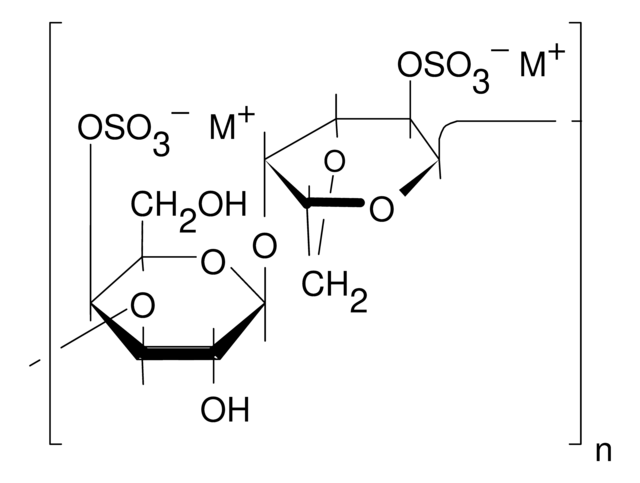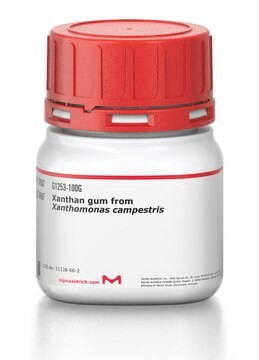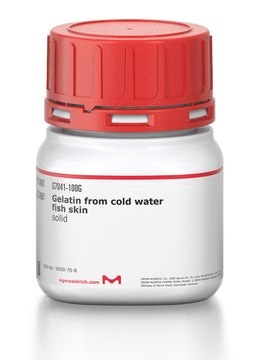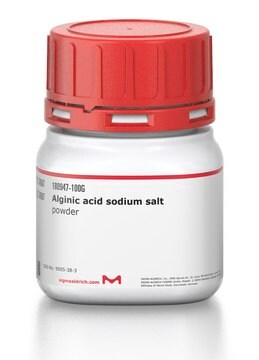C1013
Carrageenan
suitable for gel preparation
Synonym(s):
Vegetable gelatin
Sign Into View Organizational & Contract Pricing
All Photos(4)
About This Item
Recommended Products
biological source
algae (red)
description
Predominantly κ and lesser amounts of λ carrageenan
form
powder
color
white to light brown
useful pH range
7.5-10.5 (1.5% in water)
cation traces
Ca: <3.5%
K: <11%
Na: <2.0%
suitability
suitable for gel preparation
storage temp.
room temp
Looking for similar products? Visit Product Comparison Guide
General description
Carrageenans are mucopolysaccharides from the cell walls of the red algae. They are anionic linear polymers composed of 1,3α-1,4β-galactans having one (κ-), two (ι-) or three (λ-) sulfates per disaccharide unit. In ionic solutions, κ- and ι-carrageenans self-associate into helical structures that form rigid or flexible gels, respectively. λ-carrageenans do not form helices and are non-gelling. Carrageenans are used commercially as thickeners and stabilizing agents.
Application
Carrageenans are used to suppress immune response in vivo and in vitro via mechanisms believed to involve selective cytopathic effect on macrophages. As ι-, κ-, and λ-carrageenans have varying degress of sulfation, they may be studied comparatively for differences in protective, antiviral, and immunosuppression activities.
Carrageenans are used to suppress immune response in vivo and in vitro via mechanisms believed to involve selective cytopathic effect on macrophages. As ι-, κ-, and λ- carrageenans have varying degrees of sulfation, they may be studied comparatively for differences in protective, antiviral, and immunosuppression activities. Carrageenan may be used in the development of biomaterials such as bone graft substitutes; entrapping vessels such as biobeads and encapsulation vehicles for drug delivery. Carrageenan be used to develop hydrogels.
Preparation Note
Blended from various seaweeds to produce rigid gels.
Other Notes
To gain a comprehensive understanding of our extensive range of Polysaccharides for your research, we encourage you to visit our Carbohydrates Category page.
Storage Class Code
11 - Combustible Solids
WGK
WGK 3
Flash Point(F)
Not applicable
Flash Point(C)
Not applicable
Personal Protective Equipment
dust mask type N95 (US), Eyeshields, Gloves
Choose from one of the most recent versions:
Already Own This Product?
Find documentation for the products that you have recently purchased in the Document Library.
Ahu Uraz et al.
Journal of clinical and experimental dentistry, 5(1), e23-e29 (2014-01-24)
The objective of this study was to histologically and histomorphometrically evaluate the efficacy of the new formulations of eggshell-derived calcium carbonate in rats. The study was conducted on 30 adult male rats. Four standardized and circular intrabony defects were created
José A Fernández-Romero et al.
Antimicrobial agents and chemotherapy, 56(1), 358-368 (2011-11-09)
Topical microbicides that block the sexual transmission of HIV and herpes simplex virus 2 (HSV-2) are desperately needed to reduce the incidence of HIV infections worldwide. Previously we completed phase 3 testing of the carrageenan-based gel Carraguard. Although the trial
S Nicklin et al.
Food additives and contaminants, 6(4), 425-436 (1989-10-01)
Carrageenans are a group of high molecular weight sulphated polygalactans which find extensive use in the food industry as thickening, gelling and protein-suspending agents. Although there is no evidence to suggest that the persorption of small amounts of carrageenans across
Bangde Li et al.
PloS one, 8(1), e54975-e54975 (2013-01-30)
Topical microbicides are a promising solution to address the global threat of HIV and other sexually transmitted infections. To be successful, a microbicide not only needs to be biologically functional but also highly acceptable to users. User acceptability of microbicides
Reuben H Fan et al.
NMR in biomedicine, 21(6), 566-573 (2007-11-29)
Integrated diffusion tensor T(2) measurements were made on normal and edematous rat muscle, and the data were fitted with one- and two-compartment models, respectively. Edematous muscle exhibited a short-lived component (T(2) = 28 +/- 6 ms), with diffusion characteristics similar
Our team of scientists has experience in all areas of research including Life Science, Material Science, Chemical Synthesis, Chromatography, Analytical and many others.
Contact Technical Service








